Intrigued by the tales of pilgrimage and reverence? Bethlehem beckons. This Palestinian city, separate from Jerusalem and steeped in religious history, is a must-do for any Christian seeking a deeper connection to the birthplace of Jesus.
But Bethlehem offers more than just holy sites. It’s a bustling town with a unique blend of cultures and a glimpse into the lives of modern Palestinians.
Join us as we navigate a day trip to Bethlehem, exploring its sacred grounds, indulging in delicious Middle Eastern fare, and encountering the warmth of the local people.
Why Bethlehem is important
Bethlehem holds immense significance for Christians as the birthplace of Jesus Christ. The Bible prophesied the Messiah’s arrival in Micah 5:2, stating: “But you, Bethlehem Ephrathah, though you are small among the clans of Judah, out of you will come for me one who will be ruler over Israel, whose origins are from of old, from ancient times.” The New Testament confirms this prophecy by describing Jesus’ birth in Bethlehem (Matthew 2:4-6).
Bethlehem’s name in both Hebrew (“Beit Lechem” meaning “House of Bread”) and Arabic (“Bayt Laḥm” meaning “House of Meat”) reflects its long history as an agricultural center. This is particularly meaningful given that Jesus, who declared himself to be the “bread of life” (John 6:35), was born in this “House of Bread.” Additionally, the fields surrounding Bethlehem were where the temple priests raised the sacrificial lambs, making it an appropriate birthplace for Jesus, who is referred to as the “Lamb of God” (John 1:29).
But Bethlehem’s importance extends beyond the New Testament. The city is also connected to King David, a pivotal figure in Judaism and Christianity. The Bible recounts that David, a shepherd, was anointed king of Israel in Bethlehem (1 Samuel 16:13). So, Bethlehem isn’t just the birthplace of Jesus, but also the launching pad for the Davidic dynasty, which Christians believe foreshadowed the lineage of Jesus.
Furthermore, Bethlehem is revered as the burial place of Rachel, the beloved wife of the biblical patriarch Jacob (important to Judaism, Christianity, and Islam). Her tomb is a significant pilgrimage site.
How to get from Jerusalem to Bethlehem
Bethlehem is located just 6 miles from Jerusalem, so most visitors choose to visit Bethlehem on a day trip from Jerusalem.
The travel time from Jerusalem to Bethlehem can take up to an hour due to border checkpoints and the need to change guides and/or vehicles.
💡 PRO TIP: Remember, you’ll need to bring your passport to cross the border between Israel and Palestine.
Due to border restrictions and legal limitations, you cannot use a ride-sharing service like Uber or rent a car to enter the Palestinian Territories.
Here are your options for getting from Jerusalem to Bethlehem. Check this site for more detailed instructions.
- Hire a private vehicle. There are Palestinian-based companies in East Jerusalem that will pick you up in Jerusalem and drive you directly to Bethlehem. Since they handle the border crossing logistics, you’ll avoid the hassle of having to walk through the checkpoint yourself. Based on TripAdvisor reviews, you can expect to pay $150-$300 USD for a half-day or full-day trip.
- Take a public bus. Buses 21 and 231 run from East Jerusalem to the Bethlehem border crossing, but can experience delays at the checkpoints. You’ll then need to walk through the crossing and take a taxi the rest of the way into Bethlehem. Cost: 7 shekels (about $2).
- Take a guided tour from Jerusalem or Tel Aviv. Tours are a popular and hassle-free option, as the tour company handles the border crossing logistics. Half-day trips from Jerusalem to Bethleham start at around $50.
You won’t need to spend a whole day in Bethlehem if you’re only interested in seeing the main sights. Half a day should be enough.
Most guided tours from Jerusalem to Bethlehem are structured around a half-day or full-day, depending on whether you want to include places like Jericho, the Dead Sea, or Hebron (Tomb of the Patriarchs) in your Bethlehem day trip as well.
🏆 Want to see the most sights in the least time? This Half-Day Nativity Church and Bethlehem Tour packs a lot into a half-day. It includes an in-depth guided tour of the Church of the Nativity, Shepherd’s Field (where angels announced Jesus’ birth), an olive wood factory, Manger Square, and Banksy’s art on the separation wall. Transportation from Tel Aviv and Jerusalem is included.
Crossing the border between Israel and Palestine

There will be no doubt when you’ve arrived at the Israel-Palestine border. You can’t miss the looming 8-foot concrete wall, blanketed in graffiti and lined with watch towers, cameras and barbed wire.
This is an Israeli-run checkpoint, and some of the graffiti can be a very visual reminder of the difficult political situation both sides are in.
Israelis may be forbidden to enter Palestinian territory, but there are no restrictions for other tourists. Whether you’re going on a day trip or visiting for a few days, no visa is required.
The border guards will ask you to show your passport, of course. That takes mere moments. Your passage into Palestinian territory should go smoothly as long as you DON’T take photos of the checkpoint. That’s a strict no-no.

Once you enter the West Bank, all security is handled by the Palestinian Authorities. Palestinian soldiers are in uniform. You’ll see them carrying guns, just like they do in Israel. Those guns are a very effective intimidation technique, and they are meant to keep the peace.
One thing to keep in mind is that tourism dollars are a vital source of revenue to Palestine. So, relax. The Palestinian Authority are vigilant to any possible security issues.
💡 PRO TIP: Palestinians are known for their hospitality. You can honor them by accepting invitations for coffee, lunch, or dinner. Bring a gift to show your thanks, like cookies, chocolate, candies, cakes, or dates.
Eat Arab food for lunch

Depending on whether you speak Hebrew or Arabic, Bethlehem is known as “Beit Lechem” or “Bayt Laḥm”. Translated, its name means “House of Bread” (Hebrew) or “House of Meat” (Arabic), so it was rather fitting that we arrived in Bethlehem just in time for lunch.
This was a highlight of our visit, because we really enjoy Middle Eastern food. Our guide took us to a hidden place called Palms Café. We had to pass through a tempting bakery full of trays of mouth-watering local pastries, then out the back door and down some stairs to get there.
Here’s what you need to know: In the Middle East, they don’t just put out a basket of bread before a meal, they put out a spread!
The tradition is to begin a meal with a number of small salads and a basket of warm pita bread. Hummus, cole slaw, roasted eggplant, cucumber salad, Turkish salad, and red cabbage slaw …

As usual, the hardest part was to leave room for the main meal, which was our choice of falafel, meat skewers, or barbecued chicken. So Dan and I ordered different dishes so we could try two, and as good as my kebabs were, his smoky chicken was even better.
When I mentioned that I was sorry I couldn’t have tried a falafel, the waiter brought one out to try. Let me just say that if you’re a vegetarian, you’ll be in heaven. I was amazed at the light texture. It was fried to just the right amount of golden-brown deliciousness, too.
Just when we thought we couldn’t eat another bite, they served dessert – cardamom-scented Turkish coffee and a bite-sized bit of baklava. Baklava is the region’s traditional dessert, made of flaky phyllo pastry, walnuts, honey and fresh dates. Oh. My. Goodness. What a brilliant marketing move, as we’ll pass through their store on the way out….
Although the town of Bethlehem is best known as the birthplace of Jesus of Nazareth, it is also famous as the traditional burial site of patriarch Jacob’s beloved wife, Rachel. Jacob is beloved by all Peoples of the Book, so everyone wanted access to Rachel’s tomb.
This created a big problem when the high security wall was built to divide Palestine and Israel. Ultimately, they planned the border so that Israelis could still have access to Rachel’s tomb. The wall detours for a few blocks so that the tomb is on the Israeli side.
Bethlehem’s Church of the Nativity
We lugged our full tummies back onto our tour bus and soon were standing at Manger Square, where faithful Christians gather every Christmas Eve to commemorate the birth of the Messiah.
The Church of the Nativity is one of the oldest churches in the world. It was built above the cave where, according to the Bible, Jesus Christ was born to Joseph and Mary Christ.
Not really. I just wanted to see if you were paying attention!
Wait a minute … Jesus was born in a cave?
I know what you’re thinking: Nowhere in the Bible does it say Jesus was born in a cave. Mary “laid him in a manger because there was no room for them in the inn.” (Luke 2:7).
Here’s the thing: Some sources say the Greek can also mean, “she laid him in a manger because they had no space in the room.” So Jesus could easily have been born in a quiet back section of an overflowing one-room house.
Interestingly, both Justin Martyr and the Protoevangelium of James say Jesus was born in a cave. Biblical archaeologists don’t have a problem with accepting that statement because many houses in the area are still built in front of caves. The cave part would have been used for storage and stabling animals – hence the cave-manger connection.
History of the Church of the Nativity
Here’s a timeline of the church’s early history:
- 135 AD – Roman Emperor Hadrian had the Christian site converted into a worship place for Adonis, the Greek god of beauty and desire.
- 160 AD – Justin Martyr identified a specific grotto as Jesus’ birthplace.
- 326 AD – Helena, mother of Roman emperor Constantine, had a church built on the spot in 339 AD.
- It was destroyed by fire during Samaritan revolts in the mid-500s.
- 530 AD – Emperor Justinian destroyed the church so he could build the much larger church that remains today, using the same foundation

A 14-point silver star was embedded in white marble in the grotto to mark the exact spot where Jesus was actually born.
I have no idea why they chose to give the star 14 points, but it probably has some esoteric significance. I also have no clue how they could be sure that Mary gave birth in that exact location, centuries after it happened. But that’s what they claim, anyway.
In any case, the Church of the Nativity has seen renovations and additions but it’s still basically the same structure. Thus, it has been designated a World Heritage Site and is protected by UNESCO.
ⓘ Interesting fact: Jerome, who first translated the Hebrew scriptures into Latin, lived and worked in Bethlehem. He died and was buried beneath the Church of the Nativity, until his remains were moved to Rome.
What’s inside the Church of the Nativity

Because it’s so central to the Christian faith, many sects have laid claim to this church. Governments too; crusader kings were crowned there until the 12th century. When the silver star was stolen in 1847, it brought everything to a head and caused a war. It took an actual political treaty to finally settle the disagreement.
Today, the church is controlled jointly by three Christian denominations – Armenian, Greek Orthodox and Roman Catholic. Each church controls a different part of the basilica, but all share access to the grotto.
What’s in the Grotto of the Nativity

We descended the ancient stone stairs to the grotto. There, throngs of tourists waited on queue to enter the Grotto of the Nativity and kneel at the altar there.
Waiting for those few moments will take up a lot of precious visiting time. Instead, we chose to explore another part of the grotto. “The star is on the other side of this wall,” our guide told us. “This is the closest you can get without actually being in the room.”
The Roman Catholic segment under St Catherine’s Church is much more low key. Simple and sedate. This is where you’ll want to come if you wish to worship in quiet prayer and reflection.
What is Bethlehem like?

The Christmas song may ring in your head, but with nearly 30,000 inhabitants, Bethlehem isn’t such a little town anymore. We walked the few blocks back to the bus, passing a Starbucks and a shop with an inflatable Santa. And a Bethlehem wine tasting, even though most Palestinians are Muslim.
Yep, it’s all about the tourists. Kids played in the side streets while locals beckoned to us as we passed. “Two minutes. Come visit my shop for just two minutes.”
Bethlehem is known for its beautiful olive wood carvings. Our guide took us into a Christian-owned gift shop, so others could buy souvenirs and food and snacks for tomorrow’s Sabbath. The prices were good but I found a better deal on the corner. A guy was selling liter bottles of water for $1 … and he took U.S. dollars as well as Israeli shekels.
“What is life like for a Christian who lives in Palestinian territory?” we asked our Christian guide. We wanted the unique perspective of a non-Muslim/non-Jew who lives in the territory.
She began by telling us that Bethlehem is inhabited by one of the oldest Christian communities in the world. Then she continued, “Due to social pressure, Muslims will only patronize Muslim businesses, so the small Christian population must rely on income from tourists and others.”
No wonder the number of Christians still living in Bethlehem has shrunk dramatically in recent years. I’d probably emigrate, too.
Is it safe to visit Bethlehem?
Be prepared my friend, because as soon as your friends and family hear you are heading to Israel, they are going to bombard you with their concerns. You can thank the press for that; they will hype anything,, because viewers and readers translate into advertising dollars.
Here’s our advice: Don’t believe everything you hear. Instead, do your own research. Nothing can match boots-on-the-ground experience, so check Facebook, X, TikTok, and travel forums for other travelers’ recent experiences. You will likely realize that the reality of visiting Israel or spending a day in Bethlehem is nothing like the propaganda the media likes to spew.
It’s important to remember that the Gaza Strip and the West Bank are two distinct areas. The high-risk Gaza Strip lies along the Mediterranean coastline, whereas Bethlehem is located in the West Bank, which borders Jordan. It takes about 2 hours to drive from one to the other.
Plan your Bethlehem visit
- Bethlehem has many useful trip planning resources on the official website.
- Click here to see if you need a visa.
- Prepare your taste buds with our list of 8 Healthy Middle Eastern Foods You Must Try.
- For more sightseeing, see our photo album from Bethlehem.
- Google Maps offers an aerial view of Manger Square, Bethlehem. Zoom, scroll around and explore!
How to get to Bethlehem from Jerusalem
If traveling from Jerusalem to Bethlehem, locals say it’s best to leave from Damascus Gate. You can either take a taxi or Bus #21.
This website shows how to get anywhere by plane, train, bus, ferry and car.
Where to stay in Bethlehem
If you plan to stay overnight (we didn’t), Dar Sitti Aziza gets outstanding reviews. The guesthouse offers unique traditional accommodations along with free wi-fi, a flat-screen TV, air-conditioning and a mini-bar in every room. It’s only a few hundred meters from Manger Square.
For something a little more up-market, Dar Al Mauge Boutique Hotel is only 5 minutes from Manger Square. Features include free WiFi, a sauna, a seasonal outdoor pool, terrace, restaurant, bar, and views of the city.
Read more about Bethlehem
Online
- Read our related article 10 Cool Things about Bethlehem
- Learn about the Church of the Nativity and its layout here.
- Why You Should NOT Book a “Jerusalem, Dead Sea, Bethlehem, & More Group Tour” From Tel Aviv, Israel
On Amazon
- Walking Israel: A Personal Search for the Soul of a Nation
- Lonely Planet Israel & the Palestinian Territories– Wink Travel Guide
- Israel & the Palestinian Territories – Lonely Planet
Inspired? Pin this post and share it with your friends!
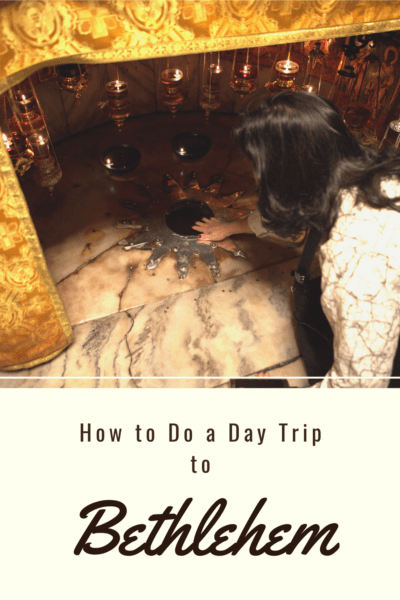

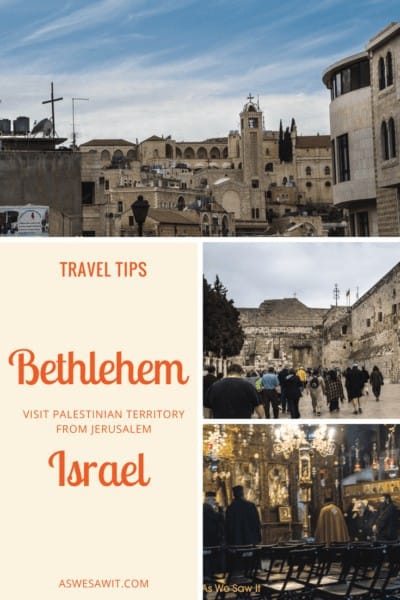
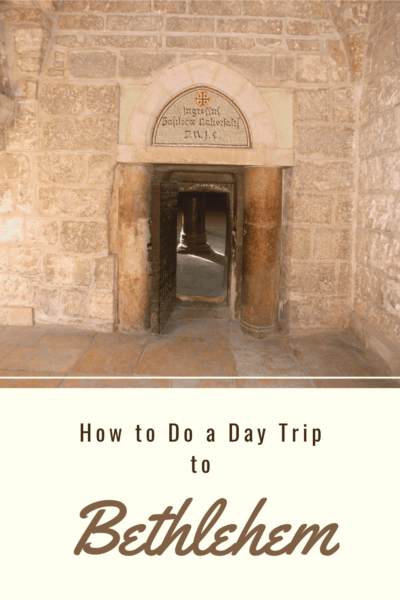
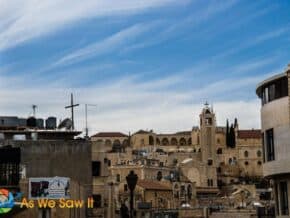

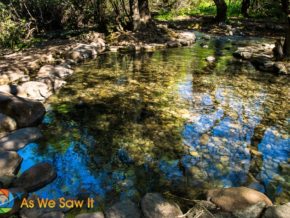
I have never been to Bethlehem. Although I’m sure I would be welcomed by the Israelis, I doubt that people from neighboring countries would like me to be there because I’m left-handed. In most countries in the middle east, the left hand should never be use so something like eating, writing, or even handing an object to someone.
The left-hand thing is something we rarely notice in our culture, but you’re right, it’s a big deal in the middle east. They say it’s because they use the left hand in the bathroom, but it must be deeper than that. After all, they DO wash their hands afterwards….
I can’t get over how beautiful that graffiti girl is. She is just so happy holding that assault rifle.
She sure does, and so fond of it she even made a ring out of a bullet!
I just got back from Montenegro. Considering the country is younger than my second graders, the phrase “I’m traveling to the Balkans” had my parents worried. The scars of war are still there, but because both Croatia and Montenegro are becoming part of the EU, they’ve had to make friends.
Nice write up, but one correction needed. “Today the church is controlled jointly by three Christian denominations – Armenian, Roman Catholic. Each church controls a different part of the basilica, but all have access to the grotto.” Only two denominations are listed. Otherwise, you’ve captured it just the way I remember it.
Thanks for the compliment, Kevin. And kudos to you and Chris who both found my error. I really appreciate the heads up. It seems I had deleted more than I’d thought when I found those random codes in my text. You guys rock!